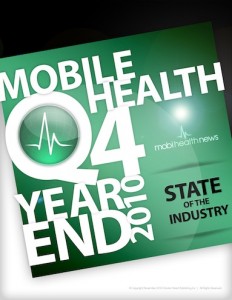 At the end of each calendar year quarter, MobiHealthNews pieces together the most important news, commentary, deals and analysis into a "state of the industry" report available in our premium content section (here). What follows are excerpts from the Payors chapter of MobiHealthNews' Fourth Quarter: Mobile Health State of the Industry Report.
At the end of each calendar year quarter, MobiHealthNews pieces together the most important news, commentary, deals and analysis into a "state of the industry" report available in our premium content section (here). What follows are excerpts from the Payors chapter of MobiHealthNews' Fourth Quarter: Mobile Health State of the Industry Report.
During the fourth quarter of 2010 health plans and other payors pushed the mobile health industry forward with a number of key move. Perhaps most importantly, Centers for Medicare and Medicaid Services Administrator Don Berwick appointed Dr. Richard Gilfillan “Acting” Director of the new Center for Medicare and Medicaid Innovation (CMI), which is tasked with developing “innovative payment and service delivery models to reduce program expenditures… while preserving or enhancing quality of care.” In its National Broadband Plan the Federal Communications Commission (FCC) pointed to the CMI as a test bed of innovation for mobile health that could help expedite reimbursement for mHealth services.
As CMS began to set up its new innovation center, private payers began to take mobile health more seriously. Dr. Richard Migliori, executive vice president of UnitedHealth Group, told MobiHealthNews that mobile health can help improve access to care and help the increasingly overburdened physician base better meet the needs of patients. Migliori explained the role of mobile apps backed by employer incentives in bringing about the payer’s vision for mobile health. Interestingly, United, itself, is among those employers that is using mobile health apps to help employees achieve wellness benchmarks. Above all else, however, Miglori said that mobile health can help payers establish a more personal relationship with its members:
“Health is built on intimacy,” Migliori said. “Whether we are sharing this information with a patient or physician, we think that mobile technology will allow us to become a greater part of their lifestyle, because we are joining their lifestyle not trying to redirect it. For physicians we are trying to become more deeply embedded in their workflow rather than distracting them. We knew we had built robust and precise tools that people could use to improve their health status. What we needed to do was step up the game in terms of getting people to take advantage of it. To do that it wasn’t a matter of doing something more sophisticated, it was a matter of becoming a bigger part of their lives.”
Humana is another payor that began to court the mobile health industry during the fourth quarter: “Mobile devices – from cell phones to iPads, eReaders to Nintendo DS – are becoming essential tools for monitoring our health and wellbeing, thanks to their ability to access and share information anywhere,” Raja Rajamannar, senior vice president and chief innovation and marketing officer at Humana, told MobiHealthNews in an interview this past November. “Many of today’s five billion cell phone users, for instance, can use global-positioning satellite, or GPS, to locate health clinics, download medical information and even find healthy restaurant options in their area. Mobile applications also can monitor health progress, helping to shift consumer behaviors toward managing wellness and away from treating sickness.”
A couple of health insurers also launched their own apps and mobile websites: Blue Cross and Blue Shield of North Carolina recently launched an iPhone, iPad and iPod touch app called HealthNAV, which helps users find the closest urgent care center to them. The app also provides a place for notes about prescriptions, reminders and questions for their next appointment, and a medication’s price guide. CIGNA launched a mobile website for its 11 million members that enables them to get answers about what their health plans cover. Importantly, the site provides answers in both English and Spanish.
Private payors are finally engaging with mobile health tools as they seek to engage their patient populations with preventive tools and services. Meanwhile, CMS is poised to investigate new payment models for innovative care delivery models, including those mobile health services highlighted by the FCC in its National Broadband Plan.
Get your copy of our newest paid research report here: Fourth Quarter: Mobile Health State of the Industry Report
Interested in a 2011 subscription to receive all of our research reports? Send us a note here
















